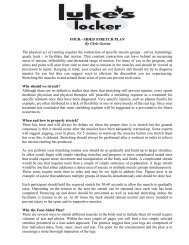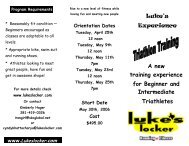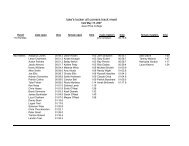TAPERING By Robert Vaughan, PhD and bob Wilder M.D.
TAPERING By Robert Vaughan, PhD and bob Wilder M.D.
TAPERING By Robert Vaughan, PhD and bob Wilder M.D.
Create successful ePaper yourself
Turn your PDF publications into a flip-book with our unique Google optimized e-Paper software.
the equation. When the regeneration phase is ignored, fatigue increases to the point of overtraining or<br />
chronic fatigue.<br />
Fatigue, which limits performance in endurance events, is for the most part peripheral in nature.<br />
<strong>By</strong> peripheral we mean fatigue occurs in the muscles involved in the activity. The muscles engaged in<br />
long term, repetitive activity become depleted of glycogen <strong>and</strong> unable to produce the force required to<br />
maintain speed in long term aerobic activities, such as marathon <strong>and</strong> triathlon.<br />
In addition, there is a central component to fatigue. As an example: during intense, long term<br />
activity; such as running, or training for a marathon, blood glucose levels decrease <strong>and</strong> the glucose<br />
supply to the brain is diminished. Since glucose is the only fuel used by the brain, its depletion leads to<br />
muddled thought processes, clumsiness, <strong>and</strong> incoordination; the central nervous system responds less<br />
rapidly to stimulation.<br />
Fatigue in medium-duration, aerobic events such as 5000 <strong>and</strong> 10000 results from a gradual<br />
accumulation of hydrogen ions within the cell. The increased acidity causes impaired cell function, <strong>and</strong>,<br />
as with depleted energy stores, an inability to maintain the required speed. In short, middle distances,<br />
such as 800 <strong>and</strong> 1500 meters, the buildup of hydrogen ions within the cell is much more rapid, due to the<br />
intensity of the pace. No matter what the cause of fatigue, sufficient time should be given to allow<br />
regeneration <strong>and</strong> supercompensation to take place.<br />
The amount of time necessary to allow for regeneration varies from individual to individual.<br />
Research by Costill indicates that four weeks of reduced swim training by 70% will lead to no decrease in<br />
VO2 max, <strong>and</strong> no increase in lactate levels. A suggested reduction, over three weeks, of 30,50, 75% of<br />
training volume will produce excellent results just as long as a modicum of intense training is included<br />
every 72 hours. During the last week it is virtually impossible to do too little<br />
All endurance events, from 800 meters to the marathon benefit from intelligent rest <strong>and</strong><br />
regeneration. The peak results from proper application of hard work, <strong>and</strong> the intelligent removal of the<br />
training stimulus at the correct time, so that mental <strong>and</strong> physical energy reaches a peak at the same time.









